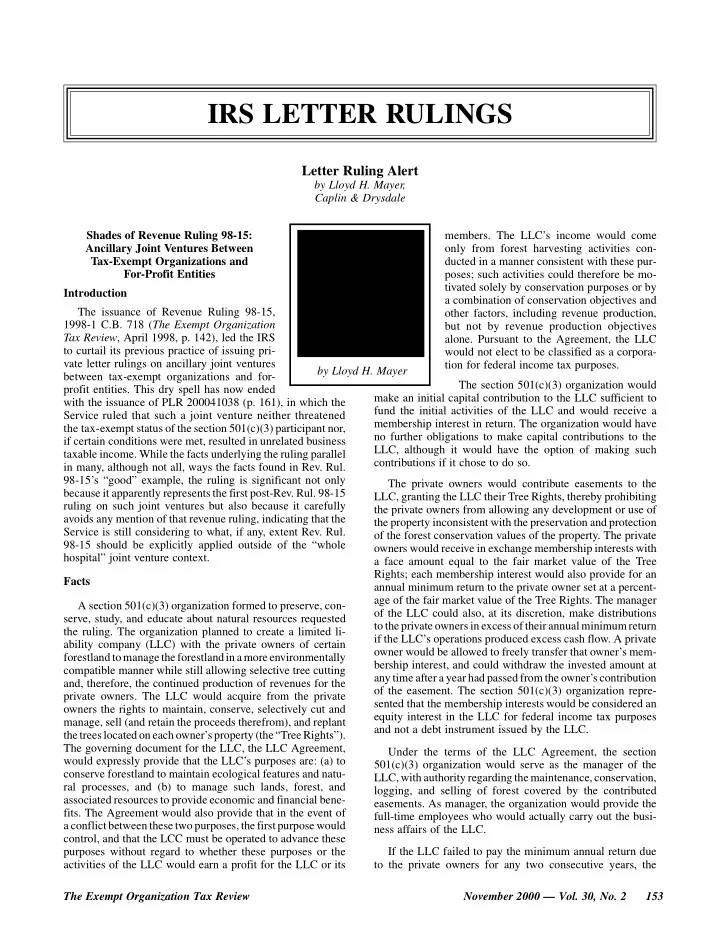

IRS LETTER RULINGS Letter Ruling Alert by Lloyd H. Mayer, Caplin & Drysdale Shades of Revenue Ruling 98-15: members. The LLC’s income would come Ancillary Joint Ventures Between only from forest harvesting activities con- Tax-Exempt Organizations and ducted in a manner consistent with these pur- For-Profit Entities poses; such activities could therefore be mo- tivated solely by conservation purposes or by Introduction a combination of conservation objectives and The issuance of Revenue Ruling 98-15, other factors, including revenue production, 1998-1 C.B. 718 ( The Exempt Organization but not by revenue production objectives Tax Review , April 1998, p. 142), led the IRS alone. Pursuant to the Agreement, the LLC to curtail its previous practice of issuing pri- would not elect to be classified as a corpora- vate letter rulings on ancillary joint ventures tion for federal income tax purposes. by Lloyd H. Mayer between tax-exempt organizations and for- The section 501(c)(3) organization would profit entities. This dry spell has now ended make an initial capital contribution to the LLC sufficient to with the issuance of PLR 200041038 (p. 161), in which the fund the initial activities of the LLC and would receive a Service ruled that such a joint venture neither threatened membership interest in return. The organization would have the tax-exempt status of the section 501(c)(3) participant nor, no further obligations to make capital contributions to the if certain conditions were met, resulted in unrelated business LLC, although it would have the option of making such taxable income. While the facts underlying the ruling parallel contributions if it chose to do so. in many, although not all, ways the facts found in Rev. Rul. 98-15’s “good” example, the ruling is significant not only The private owners would contribute easements to the because it apparently represents the first post-Rev. Rul. 98-15 LLC, granting the LLC their Tree Rights, thereby prohibiting ruling on such joint ventures but also because it carefully the private owners from allowing any development or use of avoids any mention of that revenue ruling, indicating that the the property inconsistent with the preservation and protection Service is still considering to what, if any, extent Rev. Rul. of the forest conservation values of the property. The private 98-15 should be explicitly applied outside of the “whole owners would receive in exchange membership interests with hospital” joint venture context. a face amount equal to the fair market value of the Tree Rights; each membership interest would also provide for an Facts annual minimum return to the private owner set at a percent- age of the fair market value of the Tree Rights. The manager A section 501(c)(3) organization formed to preserve, con- of the LLC could also, at its discretion, make distributions serve, study, and educate about natural resources requested to the private owners in excess of their annual minimum return the ruling. The organization planned to create a limited li- if the LLC’s operations produced excess cash flow. A private ability company (LLC) with the private owners of certain owner would be allowed to freely transfer that owner’s mem- forestland to manage the forestlandin a more environmentally bership interest, and could withdraw the invested amount at compatible manner while still allowing selective tree cutting any time after a year had passed from the owner’s contribution and, therefore, the continued production of revenues for the of the easement. The section 501(c)(3) organization repre- private owners. The LLC would acquire from the private sented that the membership interests would be considered an owners the rights to maintain, conserve, selectively cut and equity interest in the LLC for federal income tax purposes manage, sell (and retain the proceeds therefrom), and replant and not a debt instrument issued by the LLC. the treeslocatedon each owner’sproperty(the“TreeRights”). The governing document for the LLC, the LLC Agreement, Under the terms of the LLC Agreement, the section would expressly provide that the LLC’s purposes are: (a) to 501(c)(3) organization would serve as the manager of the conserve forestland to maintain ecological features and natu- LLC, with authority regarding the maintenance,conservation, ral processes, and (b) to manage such lands, forest, and logging, and selling of forest covered by the contributed associated resources to provide economic and financial bene- easements. As manager, the organization would provide the fits. The Agreement would also provide that in the event of full-time employees who would actually carry out the busi- a conflict between these two purposes, the first purpose would ness affairs of the LLC. control, and that the LCC must be operated to advance these If the LLC failed to pay the minimum annual return due purposes without regard to whether these purposes or the activities of the LLC would earn a profit for the LLC or its to the private owners for any two consecutive years, the The Exempt Organization Tax Review November 2000 — Vol. 30, No. 2 153
Recommend
More recommend